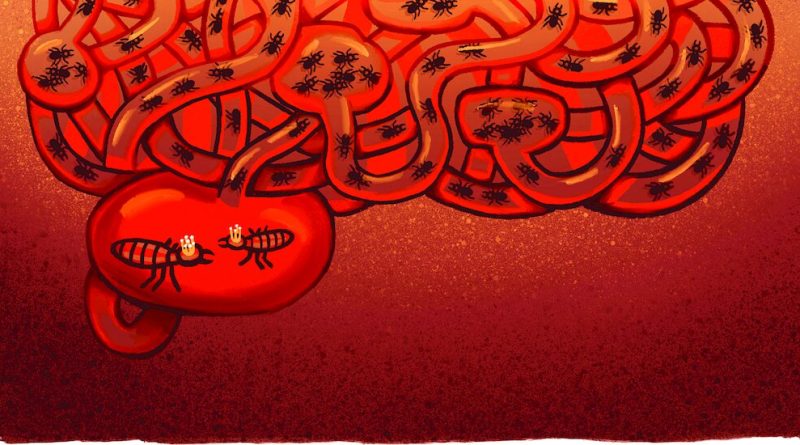All Hail the King (of the Termites)
[ad_1]
While millions of eyes are on the coronation of Charles III this weekend, other male monarchs will carry on ruling in obscurity — literal obscurity, because they live in darkness underground, or maybe in a piece of rotting wood.
Queens are familiar figures among insect species. But it is only in termites that royal families include kings. Long-lived, ensconced in fortified royal chambers and faithful to their enormous queens, these rulers are unique in the insect realm.
“There are some parallels to our monarchy system for humans,” said Barbara Thorne, a termite biologist and professor emerita at the University of Maryland.
Termites, like many ant, bee and wasp species, live in collaboratives of sterile workers. But there are crucial differences.
In the nests of ants, bees or wasps, the sole monarch is a queen. She stores all the sperm she will need for the rest of her life after a single, eventful mating flight. She uses the stored sperm to produce daughters, who take on all the work of finding food and caring for their younger siblings.
Termites evolved separately from these other insects, and they do things their own way. For starters, both a queen and a king are needed to start a termite colony. The reason isn’t romantic: Female termites can’t store sperm, so they need a male to inseminate them over and over. A study of one species found that it happened daily.
King and queen work together to get their family started. The male “helps with every aspect of it,” Dr. Thorne said, “from the brood care to nurturing, feeding, providing water, attending his queen.”
Soon, though, the royal couple steps back. They keep making babies, but let grown offspring handle the forage and child care. Those helpful kids are both male and female, a society of brothers and sisters working together. Some also grow up to become soldiers specially built for defending their colonies.
The queen and king don’t set themselves apart with crowns or other regalia, but they do start out in adulthood with wings, which they shed as they’re settling down. The queen becomes “ginormous, just a big sac of ovaries, basically,” said Ed Vargo, an entomologist at Texas A&M University. The king, while dwarfed by his bride, is still larger than the workers, and usually the soldiers.
Termites can’t see those differences, as they live in the dark. But Dr. Vargo’s lab has shown that workers and soldiers can recognize their sovereigns by smell. When another termite is near a queen or a king, it shakes its body, perhaps alerting others that they’re in the presence of royalty.
And although they don’t have a castle, Dr. Thorne said, “They do have a special royal cell with a little chamber that’s primarily the queen and king.” Deep within the nest and with thicker walls, this chamber protects the queen and the king if, say, an anteater takes a swipe.
As the royals don’t leave their chamber, workers give them regurgitated food from their own mouths. Other colony-living insects spike their mouth-to-mouth meals with chemicals for communication, Dr. Vargo said. It’s possible that termites do the same thing. For now, though, the makeup of these termite meals is as mysterious as the “secret mixture of oils” with which Charles III will be anointed, using the centuries-old coronation spoon.
The termite king, performing his marital duties, helps his mate produce as many as 15,000 eggs each day. When the king or the queen eventually dies, a replacement will come from among these heirs and many, many spares. “The reproductive throne is inherited by one or more of their offspring,” Dr. Thorne said.
In rags-to-riches style, the first termites evolved from cockroaches. Why they became so cooperative is a bit of a puzzle. Ants, bees and wasps have a genetic system that makes the females in a family more closely related than usual; this may be part of why queen-led colonies evolved several times in these insects. But a termite colony is no more related than a human family (at least until the inbreeding starts). Whatever led them to evolve coed, cooperative societies, Dr. Vargo said, it happened only once in history.
Today they have expanded into about 2,600 highly cooperative species. “Termites are amazing, and super important in their native habitats for decomposition and recycling of nutrients,” Dr. Thorne said. But our interactions with those societies are mostly negative since, she said, “We build our houses out of termite food.”
The termite monarchy also offers a window into the science of longevity. Like ant, bee or wasp queens, termite royals can live substantially longer than their subjects. Workers may live a few months, while termite royals have survived 20 years in laboratories.
Eisuke Tasaki, a biologist at Niigata University in Japan, said termite kings have a distinctive set of molecular tools that slow their aging, such as more active genes for DNA repair.
“Unraveling the molecular mechanisms of termite king longevity may shed light on the mysteries of life span regulation in male individuals” in all animals, Dr. Tasaki said.
Long live the king, indeed!
